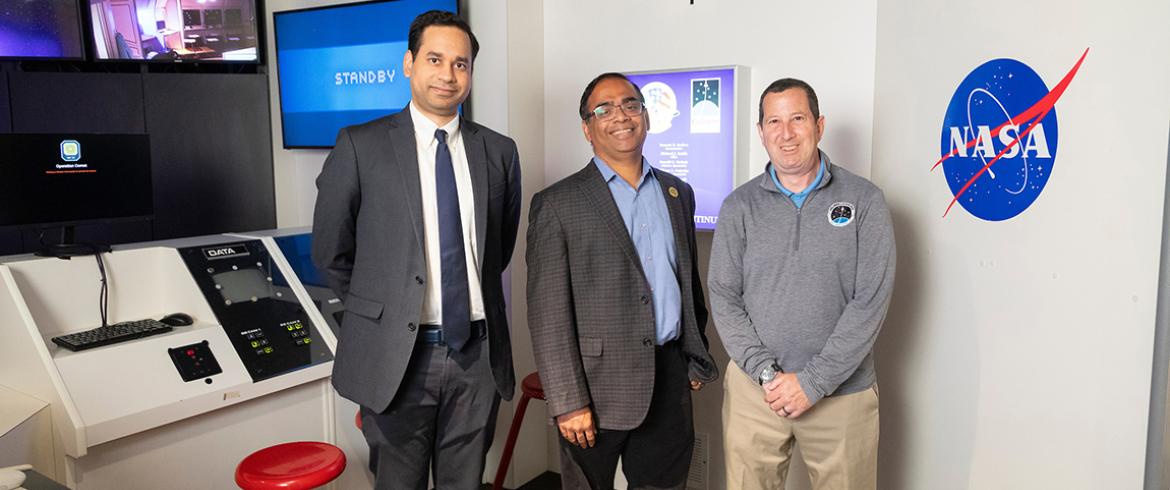
(L-R) Jamel Ali, Ph.D., Subramanian Ramakrishnan, Ph.D., and Challenger Learning Center of Tallahassee Executive Director Alan Hanstein pose in the Space Station Laboratory of the Space Mission Simulator in the Challenger Learning Center of Tallahassee. Ali and Ramakrishnan were awarded a NASA Minority University Research and Education Project Established Research Opportunity (MIRO) grant through FAMU for their work with Integrative Space Additive Manufacturing at FAMU-FSU College of Engineering. (Scott Holstein/FAMU-FSU College of Engineering)
Researchers at the FAMU-FSU College of Engineering are embarking on a groundbreaking NASA-funded project to develop advanced manufacturing processes for space exploration.
This initiative aims to enhance space-age technologies and bolster representation among minority engineers in the high-tech space industry.
The project, led by Subramanian Ramakrishnan and co-directed by Jamel Ali, focuses on creating composite materials that support sustainable operations for exploration missions, aligning with NASA's In-Space Manufacturing (ISM) program. A core objective is establishing design rules for 3D printing on curved surfaces, enabling versatile applications. A strong secondary objective is bolstering the research infrastructure at Florida A&M University (FAMU) and creating opportunities for future underresourced engineers to envision a future in the space industry.
“Collaboration is crucial for a project like this,” Ramakrishnan said. “We’re working with NASA’s Goddard and Marshall Space Flight Centers and industry partners like nScript and the Mayo Clinic.”
Ramakrishnan highlighted the significance of the partnership between Florida A&M University and Florida State University (FSU). “This project demonstrates the power of the joint college, especially in research and education,” he added.
Empowering the Next Generation of Engineers
A primary goal of the initiative is to strengthen FAMU's infrastructure and mentor a new generation of minority students in space-related fields. Graduate and undergraduate students will be able to participate in research and internships at the two NASA centers, gaining hands-on experience in the space industry.
Margaret Samuels, the 3D Printing Electronics Group Team Lead at NASA Goddard, explained the unique learning opportunities for students. “Engineering for space requires a different mindset,” Samuels said. “As any NASA engineer will tell you, we often get one shot to get it right. Students will be involved in exhaustive design, testing and iteration processes.”
She also emphasized NASA’s commitment to initiatives like the MIRO grants, which seek to bring multicultural voices into science and engineering discussions.
The project aims to produce African American and Hispanic Ph.D. graduates and directly impact 30-40 undergraduates, potentially reaching hundreds more through expanded research infrastructure, internships and outreach programs.
Inspiring Young Minds in STEM
The program extends beyond college students, engaging younger students at community colleges, middle schools and high schools. Through a partnership with the college’s Challenger Learning Center (CLC) in Tallahassee, the initiative offers K-12 STEM outreach programs that provide hands-on experiences, such as simulated space missions.
“Getting kids interested in STEM early is crucial,” said Alan Hanstein, CLC executive director. “Early STEM exposure fosters critical thinking, creativity and problem-solving skills. It helps children see real-world applications, inspiring them to pursue STEM careers.”
The CLC’s programs include interactive learning opportunities like coding robots and exploring the night sky at the planetarium, aiming to ignite curiosity and passion for STEM fields.
Building Stronger Partnerships
The research team includes experts from the FAMU-FSU College of Engineering, Florida State University, the Mayo Clinic and a varied group of students. “Our team includes Dr. Satyanarayanan Dev from FAMU, Dr. Richard Liang, and Dr. Emily Pritchard from FSU,” Ramakrishnan said. “We also have dedicated students involved, including postdoc Gabriela Plautz, graduate student Md Alamgir Hossain, and undergraduates Joshua Davey and Alex Morisette.”
With support from NASA and industry collaborators, the college aims to strengthen long-term partnerships and inspire a new generation of students to pursue STEM careers. “This project builds on FAMU’s recent accomplishments, including the NSF-funded additive manufacturing CREST Center,” Ramakrishnan noted. “We’re committed to training the next generation of minority students in space research and improving HBCU infrastructure.”
The initiative is made possible by the Minority University Research and Education Project Established Research Opportunity (MIRO) award, which allocated $5 million to FAMU, one of seven minority-serving institutions selected for this funding.
